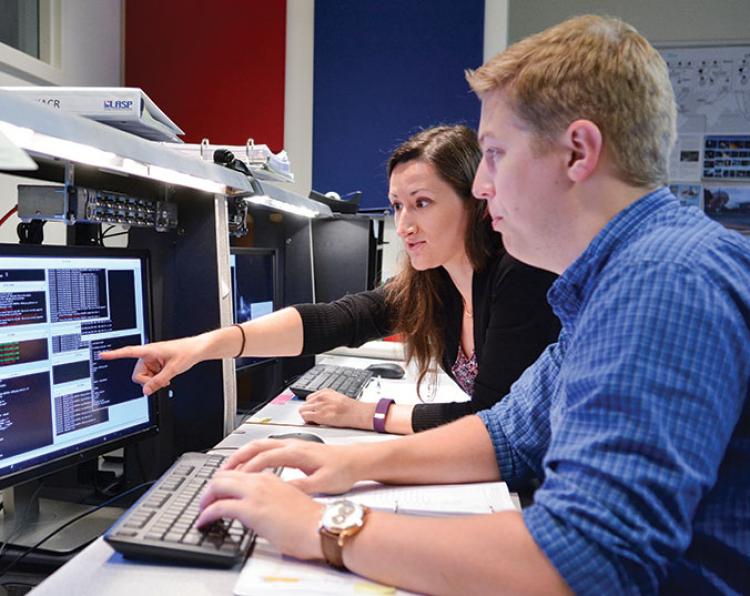For a team of CU Boulder students and scientists studying climate change on Mars, the answer is “blowin’ in the wind”
Why did Mars morph from a warm, wet and possibly habitable planet several billion years ago to the cold, dry and barren environment we see today?
Blame it in large part on a ferocious wind that can scream off the sun at speeds of more than a million miles per hour, says Professor Bruce Jakosky. He’s the prin-cipal investigator of National Aeronautics and Space Administration’s (NASA’s) Mars Atmosphere and Volatile EvolutioN Mission (MAVEN) mission now orbiting the Red Planet.

About 120 CU Boulder students, including Graduate Research Assistants Sierra Flynn and Evan Graser, are getting hands-on space experience at LASP.
Scientists believe the solar wind was more active and powerful during Mars’ formative years, stripping away much of the planet’s atmospheric gas. “Like the theft of a few coins from a cash register every day, the loss becomes significant over time,” explains Jakosky, also associate director of CU Boulder’s Laboratory for Atmospheric and Space Physics (LASP). “More importantly, with MAVEN we’ve seen that the atmospheric erosion increases significantly during solar storms.”
"What we are really trying to do is understand our relationship to the universe around us," said Jakosky.
Those storms are essentially a stream of particles made up primarily of protons and electrons. All planets in our solar system are hit by solar wind, but because Mars has no magnetic field protecting it, the storms in-teract directly with the Martian atmosphere to strip it away. The solar wind strips the Red Planet’s atmosphere in distinct regions, with ions primarily escaping via plumes above the Martian poles and a “tail” of wind flowing behind the planet. This tail accounts for nearly 75 percent of the planet’s atmospheric loss, a recent study found.
Several billion years ago, when Mars still had a magnetic field, the atmosphere there was likely much denser and warm enough to form rivers, lakes and perhaps even oceans. In a broader sense, MAVEN should help scientists and citizens better understand not only Mars, but also the solar system and beyond. “What we are really trying to do is understand our relationship to the universe around us,” said Jakosky. “That includes what it means to be alive and what it means to be a civilization. By exploring the universe, we are exploring the human condition.”
In addition to Jakosky’s role as mission leader, the MAVEN science team includes three LASP scientists heading up instrument groups—Nick Schneider, Frank Eparvier and Robert Ergun—as well as a supporting team of scientists, engineers, mission operations specialists and students from CU Boulder. One of the hallmarks of LASP is the involvement of students in every aspect of its space missions, including MAVEN, says Jakosky.
“At LASP we have about 120 students working on different aspects of flight projects ranging from engineering and spacecraft operations to data management and science analysis,” he explains. “When these students graduate, they find themselves very much in demand around the country because they have tremendous experience.”
But they may end up in jobs right here in Colorado. In addition to CU Boulder’s role, Lockheed Martin Space Systems of Littleton built the spacecraft and is responsible for mission operations, while United Launch Alliance of Centennial provided the launch vehicle. The mission has contributed more than $300 million to the Colorado economy.
Principal Investigator
Bruce Jakosky
Funding
National Aeronautics and Space Administration (NASA)
Collaboration/Support
Laboratory for Atmospheric and Space Physics (LASP); Mars Atmosphere and Volatile EvolutioN (MAVEN)



